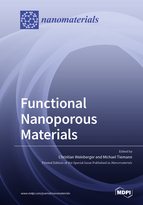Functional Nanoporous Materials
A special issue of Nanomaterials (ISSN 2079-4991).
Deadline for manuscript submissions: closed (31 December 2019) | Viewed by 31820
Special Issue Editors
Interests: material characterization; nanomaterials; X-ray diffraction; nanomaterials synthesis; XRD analysis; adsorption; materials chemistry; heterogeneous catalysis; kinetics; catalyst characterization; catalyst Synthesis; catalysis; porous materials; electrochemistry
Interests: material characterization; materials; nanomaterials; thin films and nanotechnology; X-ray diffraction; synthesis; material characteristics; advanced materials; nanomaterials synthesis; thin film deposition; SEM analysis; nanostructured materials; nanoparticle synthesis
Special Issues, Collections and Topics in MDPI journals
Special Issue Information
Dear Colleagues,
With pore sizes up to 100 nm, the term "nanoporous" covers a wide range of material classes. Likewise, a broad field of applications arises from the diversity of unique structures and properties of nanoporous materials. Recent research spans the entire range from fundamental studies of the behavior of atoms/molecules in confined space, over creative synthetic pathways for novel materials, to the application in high-performance technologies.
This Special Issue collects current studies about the progress in the development, characterization, and application of nanoporous materials, including (but not restricted to) mesoporous silica, carbon and metal oxides, porous coordination polymers, metal organic frameworks (MOF) and covalent organic frameworks (COF), as well as materials exhibiting hierarchical porosity. Their functionalities make them promising for such fields as energy storage/conversion (e.g., photocatalysis and battery electrodes), sensing, catalysis, and their sorption properties for N2, CO2, NOx or H2O, to name just a few.
Dr. Christian Weinberger
Prof. Dr. Michael Tiemann
Guest Editors
Manuscript Submission Information
Manuscripts should be submitted online at www.mdpi.com by registering and logging in to this website. Once you are registered, click here to go to the submission form. Manuscripts can be submitted until the deadline. All submissions that pass pre-check are peer-reviewed. Accepted papers will be published continuously in the journal (as soon as accepted) and will be listed together on the special issue website. Research articles, review articles as well as short communications are invited. For planned papers, a title and short abstract (about 100 words) can be sent to the Editorial Office for announcement on this website.
Submitted manuscripts should not have been published previously, nor be under consideration for publication elsewhere (except conference proceedings papers). All manuscripts are thoroughly refereed through a single-blind peer-review process. A guide for authors and other relevant information for submission of manuscripts is available on the Instructions for Authors page. Nanomaterials is an international peer-reviewed open access semimonthly journal published by MDPI.
Please visit the Instructions for Authors page before submitting a manuscript. The Article Processing Charge (APC) for publication in this open access journal is 2900 CHF (Swiss Francs). Submitted papers should be well formatted and use good English. Authors may use MDPI's English editing service prior to publication or during author revisions.
Keywords
- nanoporous silica, carbon, metal oxide
- porous coordination polymer
- metal organic framework (MOF)
- covalent organic frameworks (COF)
- hierarchical porosity
- photocatalysis
- batteries
- gas sensing
- catalysis
- water sorption







